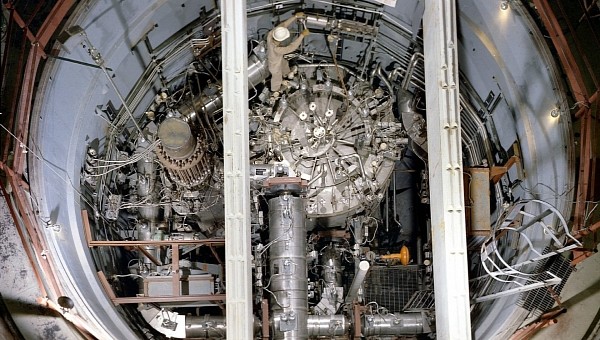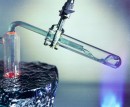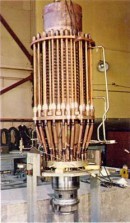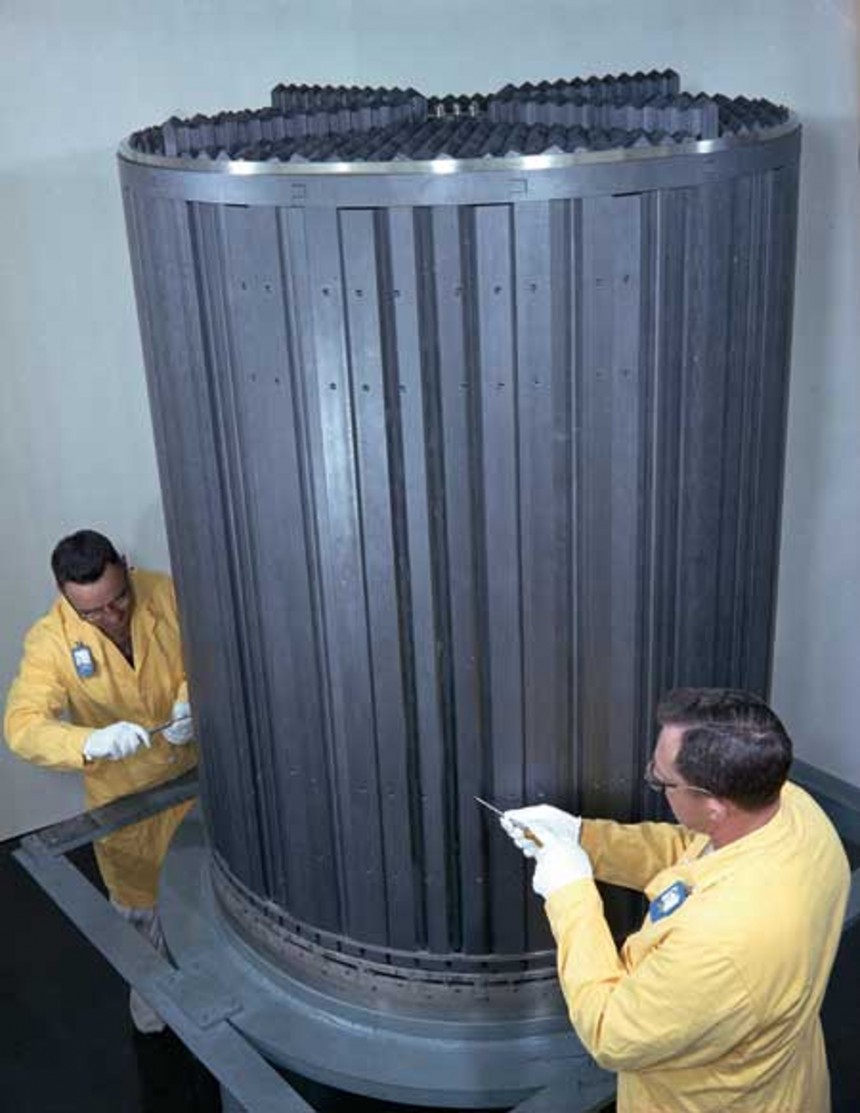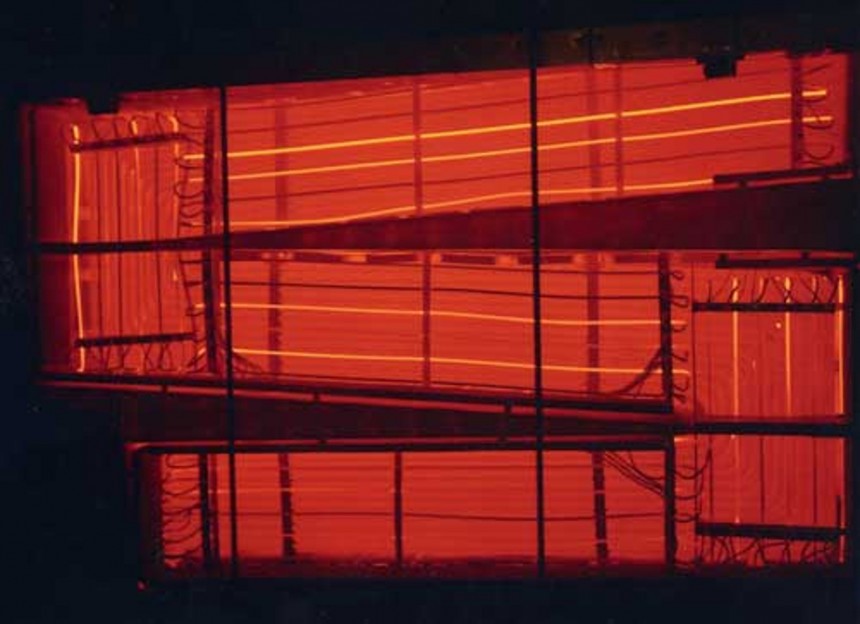When the National Ignition Facility in Livermore, CA, achieved a fusion energy gain factor of 1.6 on a test of its laser-based fusion reactor, the response was either utter elation or jaded skepticism. What wasn't up for debate was whether commercial fusion power was possible in the near future. The answer is a resounding NO.
That's why it's important to avoid getting caught napping when it comes to the nuclear fission side of things. Last time around, we talked about a Westinghouse micro reactor that could one day vanquish diesel generators. But if you fancy something grander, something more likely to knock your socks off with how advanced and futuristic it is? We got you, fam. Are you ready to get extra salty? This is the low-down on molten salt fast reactors.
We need not enter another long diatribe about the particulars of how nuclear fission works, so we'll keep it short. Fissile neutrons flung off from a fission reaction collide with nearby neutrons in a critical chain reaction that gives off lots of convertible thermal energy. In most typical reactors in operation today, fissile nuclear cores are surrounded by a neutron moderator material to keep the reaction from spiraling out of control.
From there, some form of cooling material, usually light water, heavy water, or both, transfers this thermal energy into usable electricity through a series of turbines. Pretty simple in principle, but there are ways of spicing things up. Water isn't the only cooling material scientists can use to operate fission reactors. Admittedly, experimental MSRs are nothing new. Two experiments by the Oak Ridge National Laboratory of Tennessee in the 1950s and 1960s are a testament to this.
In this experiment, it was found that sodium compounds heated to lava-like temperatures transferred the thermal energy of fissile nuclear cores just as well as water and even better in some instances. Originally intended to power some utterly bonkers supersonic aircraft concept, scientists at Oak Ridge soon realized how obtuse and dangerous of an idea this was. No offense to them. It was the early 60s, after all.
But for how wrong-headed its initial application was, Oak Ridge's first molten salt reactor proved there were plenty of ways to skin the proverbial cat in nuclear fission power. Instead of using steam turbines and boiling/high-pressure water to create electricity, the thermal energy from MSR reactors travels through a series of heat exchangers, where it can then be introduced into a closed-circuit turbine system.
Using a phenomenon called the Brayton cycle, similar mechanical workings to what happens inside an internal combustion engine can turn vast thermal heat into something that can operate a toaster, an MRI machine, or your gaming PC. With operating temperatures in excess of 700 degrees Celsius (1,292 °F), far more thermal energy can be emitted from fissile nuclear cores than had it run on water alone.
Instead of employing fissile fuel rods made from smaller pellets of radioactive material like water reactors, molten salt reactors mix the liquid salt coolant with the nuclear fuel in a solution that transfers thermal neutrons. Meanwhile, a neutron moderator material, usually graphite but sometimes water or beryllium oxide, keep the reaction unfolding at a predictable and controllable rate.
But alongside gobs of juicy thermal energy, molten salt reactors under the right conditions can actually breed more fissile material than it uses through radioactive decay. Whether breeding lithium into tritium or thorium into uranium, it doesn't take rocket scientists to realize why a semi-self-sustaining nuclear reactor, or breeder reactor, is one of the most exciting aspects of nuclear energy. Provided a hypothetical MSR is kept free of trace impurities, fissile fuel breeding can theoretically continue for the entire service life of the reactor.
Like the gasoline in a car, special blends of sodium with various elements have been formulated to facilitate a more efficient fissile reaction. Sodium bred with chlorine, lithium, or even fluorine drastically alters the behavior of critical fissile fuel undergoing neutron bombardment. Depending on the isotope, these chemical blends can even bolster the natural breeding capabilities of MSRs uncovered at Oak Ridge labs. '
Should full-scale commercial reactors be built, their radically different nuclear fuel cycle with slower neutrons compared to light water reactors could be a huge thumbs up. In theory, this benefit should dramatically reduce the time reactor waste needs to sit underground beta-decaying. So to speak, fearmongering about thousands of barrels of spent nuclear fuel chilling out in a desert cave somewhere could be put to rest. But it'd be inaccurate to say MSRs are all sunshine and rainbows. They do have some downsides.
If parking an old Alfa Romeo outside next to a saltwater beach was catastrophic, the same problems could potentially plague molten salt reactors. By the same token, the recent containment breach of a light water reactor in Minnesota would look like peanuts compared to what a molten salt reactor breach would look like. Also, one can only imagine how difficult it'd be to transport all that radioactive salt when the time does come to decommission the reactor.
For this and for many other complicated reasons, molten salt reactors have largely stayed within the realm of 3D models and blueprints. That is, apart from one exception. Over in China, the TMSR-LF1 thorium-based molten salt reactor is due to come online any day now. With the potential to crank out 2 MW of thermal energy, according to Chinese state media.
The latest reports from back in August 2022 indicate the Chinese Communist Party had approved the TMSR-LF1 for commissioning in February 2023. But close to a month after this time, there's still no word confirmed by western media to conclude this has occurred successfully. In truth, It's near impossible to verify information about most things the CCP wants to keep under wraps.
Meanwhile, MSR designs from skilled teams in the U.S., Great Britain, Canada, France, Denmark, and India might not be as far ahead as the Chinese in the field. But there is at least one thing we can almost guarantee about them all. If given the green light, they would benefit all of our lives decades before nuclear fusion is a viable possibility
We need not enter another long diatribe about the particulars of how nuclear fission works, so we'll keep it short. Fissile neutrons flung off from a fission reaction collide with nearby neutrons in a critical chain reaction that gives off lots of convertible thermal energy. In most typical reactors in operation today, fissile nuclear cores are surrounded by a neutron moderator material to keep the reaction from spiraling out of control.
From there, some form of cooling material, usually light water, heavy water, or both, transfers this thermal energy into usable electricity through a series of turbines. Pretty simple in principle, but there are ways of spicing things up. Water isn't the only cooling material scientists can use to operate fission reactors. Admittedly, experimental MSRs are nothing new. Two experiments by the Oak Ridge National Laboratory of Tennessee in the 1950s and 1960s are a testament to this.
In this experiment, it was found that sodium compounds heated to lava-like temperatures transferred the thermal energy of fissile nuclear cores just as well as water and even better in some instances. Originally intended to power some utterly bonkers supersonic aircraft concept, scientists at Oak Ridge soon realized how obtuse and dangerous of an idea this was. No offense to them. It was the early 60s, after all.
But for how wrong-headed its initial application was, Oak Ridge's first molten salt reactor proved there were plenty of ways to skin the proverbial cat in nuclear fission power. Instead of using steam turbines and boiling/high-pressure water to create electricity, the thermal energy from MSR reactors travels through a series of heat exchangers, where it can then be introduced into a closed-circuit turbine system.
Using a phenomenon called the Brayton cycle, similar mechanical workings to what happens inside an internal combustion engine can turn vast thermal heat into something that can operate a toaster, an MRI machine, or your gaming PC. With operating temperatures in excess of 700 degrees Celsius (1,292 °F), far more thermal energy can be emitted from fissile nuclear cores than had it run on water alone.
Instead of employing fissile fuel rods made from smaller pellets of radioactive material like water reactors, molten salt reactors mix the liquid salt coolant with the nuclear fuel in a solution that transfers thermal neutrons. Meanwhile, a neutron moderator material, usually graphite but sometimes water or beryllium oxide, keep the reaction unfolding at a predictable and controllable rate.
But alongside gobs of juicy thermal energy, molten salt reactors under the right conditions can actually breed more fissile material than it uses through radioactive decay. Whether breeding lithium into tritium or thorium into uranium, it doesn't take rocket scientists to realize why a semi-self-sustaining nuclear reactor, or breeder reactor, is one of the most exciting aspects of nuclear energy. Provided a hypothetical MSR is kept free of trace impurities, fissile fuel breeding can theoretically continue for the entire service life of the reactor.
Should full-scale commercial reactors be built, their radically different nuclear fuel cycle with slower neutrons compared to light water reactors could be a huge thumbs up. In theory, this benefit should dramatically reduce the time reactor waste needs to sit underground beta-decaying. So to speak, fearmongering about thousands of barrels of spent nuclear fuel chilling out in a desert cave somewhere could be put to rest. But it'd be inaccurate to say MSRs are all sunshine and rainbows. They do have some downsides.
If parking an old Alfa Romeo outside next to a saltwater beach was catastrophic, the same problems could potentially plague molten salt reactors. By the same token, the recent containment breach of a light water reactor in Minnesota would look like peanuts compared to what a molten salt reactor breach would look like. Also, one can only imagine how difficult it'd be to transport all that radioactive salt when the time does come to decommission the reactor.
For this and for many other complicated reasons, molten salt reactors have largely stayed within the realm of 3D models and blueprints. That is, apart from one exception. Over in China, the TMSR-LF1 thorium-based molten salt reactor is due to come online any day now. With the potential to crank out 2 MW of thermal energy, according to Chinese state media.
Meanwhile, MSR designs from skilled teams in the U.S., Great Britain, Canada, France, Denmark, and India might not be as far ahead as the Chinese in the field. But there is at least one thing we can almost guarantee about them all. If given the green light, they would benefit all of our lives decades before nuclear fusion is a viable possibility
